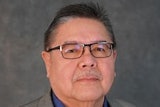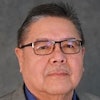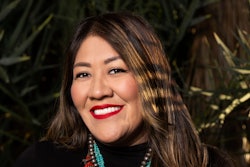“We say this story happened a long, long time ago, back when the Great Turtle Island was new…”
So begins Perry Ground before an audience at the Smithsonian’s National Museum of the American Indian in 2010. A Turtle Clan member of the Onondaga Nation, Ground is an educator who has dedicated his career to bringing traditional indigenous stories to life.
“They are human stories,” he says. “And they remind us who we are supposed to be as human beings, how we are supposed to act, how we are supposed to interact with other people and the world around us.”
 Perry Ground, second from left, helps RIT celebrate Native American Heritage Month at an event in 2012.RIT photo by Maria Sharp
Perry Ground, second from left, helps RIT celebrate Native American Heritage Month at an event in 2012.RIT photo by Maria Sharp
As the second Native American to hold the position, Ground will also serve as a cultural ambassador of sorts, working to strengthen RIT’s ties with the local Native American community.
Often seen in traditional Haudenosaunee [pronounced hoe-dee-no-SHOW-nee] clothing, such as a purple shirt with beaded detail and a feathered headdress, Ground has been telling traditional stories since the late ’80s, when he was a student at Cornell University. Ground says he turned to storytelling after observing two different ways of teaching about Native Americans at the time.
“One way involved people that I call podium pounders,” Ground says. “They would stand up to give a lecture and say something like, ‘Indians, good; White people, bad.’ And they’d literally pound on the podium sometimes.”
To him, that method was too adversarial, too divisive.
“I didn’t want to teach that way,” he says. “I wanted it to be positive, I wanted it to be inclusive. I wanted it to be welcoming and cooperative. And I saw stories as a way to achieve that.”
Weaving Native American history, culture and beliefs into his animated stories, Ground’s often seen leaping across the stage and crouching low to the ground, mimicking the animals and characters in many of his tales. His presentations and publications have been featured at schools, universities, festivals, parks and museums throughout the country.
In doing these presentations, Ground says he strives to have his audience leave feeling they’ve had a positive experience. One way he does that is by choosing to focus on the accomplishments and contributions of Native Americans. While addressing historical injustices is important, Ground says that focusing solely on tragedy risks dehumanizing native peoples and detracting from their accomplishments.
“I definitely don’t want to show native people as only victims,” he says. “I want to highlight the contributions that we made historically and continue to make today. To me, it’s just better for everyone — better for the listener and better for the person of that cultural group — because now we don’t need to be ashamed, we don’t need to be sad, we don’t need to be the victim. We can be the contributor. We can be the educator. We can be the innovator. We can take pride and happiness in the things that we’ve done.”
Ground applied this method of teaching in a recent collaboration with the Ithaca History Center and the Daughters of the American Revolution’s Chief Taughannock Chapter. In a series of videos, Ground highlights how the philosophies of the Haudenosaunee people — also known as the Iroquois — influenced the formation of American Democracy.
Formerly five different tribes within what is now the Northeastern United States, the Haudenosaunee Confederacy came into being about 1,000 years ago. A constitution called the Great Law of Peace joined the five tribes together in what is considered one of the oldest living participatory democracies on earth.
In the videos, Ground guides children through this part of American history, sharing how Haudenosaunee leaders shaped many of the founding fathers, such as Thomas Jefferson, Benjamin Franklin and James Madison — just one of many contributions that Ground highlights in the series.
At RIT, he hopes to continue teaching history through a course on the Haudenosaunee people during the spring semester, teaching the material from an ethnohistorical perspective. Additionally, he plans to teach a course solely on Native American storytelling, sharing traditions from tribes throughout the nation.
“I don’t want to talk to the students; I want to involve the students and make them part of the Native community as well,” he says. “... I hope that people that take my classes, that they have a very positive experience and at the end of it, say, ‘I can’t wait to learn more about Native Americans.’ If I can do that with one person, I’ve been successful.”
This article originally appeared in the October 28, 2021 edition of Diverse. Read it here.















